- Home
- About Journals
-
Information for Authors/ReviewersEditorial Policies
Publication Fee
Publication Cycle - Process Flowchart
Online Manuscript Submission and Tracking System
Publishing Ethics and Rectitude
Authorship
Author Benefits
Reviewer Guidelines
Guest Editor Guidelines
Peer Review Workflow
Quick Track Option
Copyediting Services
Bentham Open Membership
Bentham Open Advisory Board
Archiving Policies
Fabricating and Stating False Information
Post Publication Discussions and Corrections
Editorial Management
Advertise With Us
Funding Agencies
Rate List
Kudos
General FAQs
Special Fee Waivers and Discounts
- Contact
- Help
- About Us
- Search

The Open Ornithology Journal
(Discontinued)
ISSN: 1874-4532 ― Volume 13, 2020
Distribution of Yellow Wagtail Forms Motacilla flava – Complex in the North of Western Siberia, Russia
Mikhail G. Golovatin*, Vasiliy A. Sokolov
Abstract
On the basis of the materials obtained from the studies carried out from 2000 to 2015, we present the data on distribution of the Yellow Wagtail forms in the north of Western Siberia, i.e. within the overlapping boundaries of the ranges of a complex set of several polytypical forms – Motacilla flava sensu lato. Four forms have been identified here: two forms from the group of Western Yellow Wagtails (M. f. thunbergi and M. f. beema & flava) and two forms from the group of Eastern Yellow Wagtails (M. t. plexa and M. t. tschutschensis). Western “black-headed” form M. f. thunbergi is spread in the area of the northern taiga, forest tundra and south shrub tundra within the Ob River basin, while eastern “black-headed” form M. t. plexa is found in the shrubby tundra and further to the east from the Ob River in forest tundra and northern taiga. Western “light headed” wagtails M. f. beema & flava spread as far as 65º05'N along the floodplain of the Ob River. Eastern “light-headed” wagtail M. t. tschutschensis penetrates the Taz peninsula and, through the anthropogenic sites, the north-east coast of the Yamal Peninsula, i.e. the Sabetta area as far as 71º14'N. The entire range of the Yellow Wagtail is characterized by the interchange of zones inhabited by “black-headed” (without the expressed eyebrows on males) and “light-headed” (with notable eyebrows on males or white-headed) forms from the north to the south.
Article Information
Identifiers and Pagination:
Year: 2017Volume: 10
First Page: 1
Last Page: 9
Publisher Id: TOOENIJ-10-1
DOI: 10.2174/1874453201710010001
Article History:
Received Date: 29/08/2016Revision Received Date: 30/10/2016
Acceptance Date: 12/12/2016
Electronic publication date: 26/01/2017
Collection year: 2017
open-access license: This is an open access article licensed under the terms of the Creative Commons Attribution-Non-Commercial 4.0 International Public License (CC BY-NC 4.0) (https://creativecommons.org/licenses/by-nc/4.0/legalcode), which permits unrestricted, non-commercial use, distribution and reproduction in any medium, provided the work is properly cited.
* Address correspondence to this author at the Institute of Plant and Animal Ecology, Ural Division Russian Academy of Sciences, 202/3, 8Marta Str. Ekaterinburg, 620144, Russia; Tel: +7 9221024289; Fax: +7(343)2606500; E-mail: golovatin@yandex.ru
| Open Peer Review Details | |||
|---|---|---|---|
| Manuscript submitted on 29-08-2016 |
Original Manuscript | Distribution of Yellow Wagtail Forms Motacilla flava – Complex in the North of Western Siberia, Russia | |
1. INTRODUCTION
Yellow Wagtail is known as a complex set of polytypical forms – Motacilla flava sensu lato [1Mayr E. The interpretation of variation among the Yellow Wagtails. Br Birds 1956; 49(3): 115-9.]. Some authors describe it as a set of geographical races or subspecies of a single polytypic species e.g., [2Cramp S, Ed. The Birds of the Western Palearctic, 5. Oxford, London, New York: Oxford Univ. Press 1988., 3Dickinson EC, Ed. The Howard and Moore Complete Checklist of the Birds of the World. 3rd ed. London: Christopher Helm 2003.]. Others identify two separate groups based on differences in morphology and genomic elements, namely: western Yellow Wagtail, including such forms as flava, iberiae, cinereocapilla, thunbergi, pygmaea, beema, leucocephala, zaissanensis, flavissima, lutea, feldegg, melanogrisea, and eastern Yellow Wagtails, consisting of tschutschensis, simillima, plexa, taivana, macronyx [4Redkin JA. On the variability of some morphological traits in a group of Yellow Wagtails Motacilla flava – complex. Actual problems of study and protection of birds of Eastern Europe and Northern Asia Materials of International Conference (XI Ornithological Conference), Ed Kurochkin EN and Rakhimov II: In Russian Kazan, Publishing House Matbugat Yorty. pp. 523-524.-6Ödeen A, Björklund M. Dynamics in the evolution of sexual traits: losses and gains, radiation and convergence in yellow wagtails (Motacilla flava). Mol Ecol 2003; 12(8): 2113-30.
[http://dx.doi.org/10.1046/j.1365-294X.2003.01883.x] [PMID: 12859633] ]. Moreover, the status of independent species is proposed for M. lutea (Yellow-Headed Wagtail) and M. feldegg (Black-Headed Wagtail) among western wagtails, the rest being regarded as forms or subspecies M. flava. Separate species M. taivana (Green-crowned Yellow Wagtail), M. macronyx (Southeast Siberian Yellow Wagtail) and M. tschutschensis (Eastern Yellow Wagtail) are distinguished among eastern wagtails with the latter group combining such forms as tschutschensis, simillima, plexa [4Redkin JA. On the variability of some morphological traits in a group of Yellow Wagtails Motacilla flava – complex. Actual problems of study and protection of birds of Eastern Europe and Northern Asia Materials of International Conference (XI Ornithological Conference), Ed Kurochkin EN and Rakhimov II: In Russian Kazan, Publishing House Matbugat Yorty. pp. 523-524., 5Redkin JA. Taxonomic relationships of the forms of an evolutionarily young birds complexes on the example of the genus Motacilla L, 1785 (The taxonomic revision of subgenus Budytes) Author’s Abstract PhD. Moscow: Biology 2001; pp. 1-18. (In Russian), 7Pavlova A, Zink RM, Drovetski SV, Red’kin YA, Rohwer S. Phylogeographic patterns in Motacilla flava and Motacilla citreola: species limits and population history. Auk 2003; 120(3): 744-58.
[http://dx.doi.org/10.1642/0004-8038(2003)120[0744:PPIMFA]2.0.CO;2] ].
The most significant differences between Eastern and Western Yellow Wagtails are sexual dimorphism, which is clearer in the group of Western birds [4Redkin JA. On the variability of some morphological traits in a group of Yellow Wagtails Motacilla flava – complex. Actual problems of study and protection of birds of Eastern Europe and Northern Asia Materials of International Conference (XI Ornithological Conference), Ed Kurochkin EN and Rakhimov II: In Russian Kazan, Publishing House Matbugat Yorty. pp. 523-524., 5Redkin JA. Taxonomic relationships of the forms of an evolutionarily young birds complexes on the example of the genus Motacilla L, 1785 (The taxonomic revision of subgenus Budytes) Author’s Abstract PhD. Moscow: Biology 2001; pp. 1-18. (In Russian), 8Grichik VV. On the geographic variation of some traits that determine sexual dimorphism in Yellow Wagtails. In: Proceedings of the 10th All-Union Ornitol Conf Minsk. 1991; 1: p. 64. (In Russian), 9Grichik VV. Phenogeography of Yellow Wagtail polymorphism in connection with the problems of systematics and genesis of the complex Motacilla flava Author’s Abstract Dis PhD. Kiev: Biology 1992; pp. 1-16. (In Russian)], and the color of the juvenile plumage [10Redkin JA. Colouring of plumage of some forms of the group of Yellow Wagtails Motacilla flava sensu lato in juvenile plumage. Rus J Ornithol 2001; 10(128): 3-27. [In Russian].]. It is also believed that the Western Wagtails have rounded claws of hind toes, while the Eastern – long rounded (M. tschutschensis) or long straight claws (M. taivana, M. macronyx). Differences in outward appearance of the forms within polytypical species M.flava and M. tschutschensis are attributed to the colour of male plumage.
The most discussible form is M. f. thunbergii, common in Northern and Eastern Europe, often sympatric with nominative subspecies M. f. flava [4Redkin JA. On the variability of some morphological traits in a group of Yellow Wagtails Motacilla flava – complex. Actual problems of study and protection of birds of Eastern Europe and Northern Asia Materials of International Conference (XI Ornithological Conference), Ed Kurochkin EN and Rakhimov II: In Russian Kazan, Publishing House Matbugat Yorty. pp. 523-524., 5Redkin JA. Taxonomic relationships of the forms of an evolutionarily young birds complexes on the example of the genus Motacilla L, 1785 (The taxonomic revision of subgenus Budytes) Author’s Abstract PhD. Moscow: Biology 2001; pp. 1-18. (In Russian), 11Sammalisto L. Variations in the selective advantage of hybrids in the Finnish popula-tion of Motacilla flava L. Ann Zool Fenn 1968; 5: 196-206., 12Sotnikov VN. Birds of the Kirov region and adjacent territories Passerine Kirov: OOO Triada Plus 2006; 2(1) In (Russian)]. The coloration of the northwestern M. flava thunbergi males does not differ from the north Siberian M. tschutschensis plexa males. Coloration of the thunbergi females is similar to that of flava, bema, leucocephala forms, but differs from the plexa, tschutschensis females. Thunbergi form is believed to have resulted from hybridization of M. tschutschensis plexa males and M. f. flava females). The distributional pattern of these forms in geographical areas of their contact (especially in the north of Western Siberia) becomes significant for understanding the situation. In this paper, we present data on the distribution of different forms of Yellow Wagtails in the north of Western Siberia within the Yamal-Nenets Autonomous District, Russia.
While some authors believe that here lies the distribution area of M. flava thunbergii [13Gladkov NA. Dementiev GP, Gladkov NA, Eds. Birds of the Soviet Union. Moscow, Soviet Sci 1954; 5: pp. 594-691. (In Russian)], others consider it to be the distribution area of M. tschutschensis plexa [14Ryabitsev VK. Birds of Siberia: a bird guide. Moscow, Yekaterinburg: Cabinet Scient 2014. (In Russian)]. Latitudinally, the southern boundary of the range of these forms stretches to the Ob River as far as 56-61ºN [13Gladkov NA. Dementiev GP, Gladkov NA, Eds. Birds of the Soviet Union. Moscow, Soviet Sci 1954; 5: pp. 594-691. (In Russian)-15van Oosten HH, Emtsev AA. Putative segregation of two Yellow Wagtail taxa by breeding habitat in Western Siberia: possible implications for Motacilla flava taxonomy. Ardea 2013; 101: 65-70.
[http://dx.doi.org/10.5253/078.101.0110] ]. The northern Yellow Wagtails meet here with M. flava beema, which is more common in the south. In the sympatric zone, the subspecies are well-distinguished by their biotopical preferences: for nesting, thunbergi (plexa) mainly selects moss tussock marshes, while beema prefers the meadows, lowland bogs and anthropogenic habitats (fields of perennial grasses, wasteland) [15van Oosten HH, Emtsev AA. Putative segregation of two Yellow Wagtail taxa by breeding habitat in Western Siberia: possible implications for Motacilla flava taxonomy. Ardea 2013; 101: 65-70.
[http://dx.doi.org/10.5253/078.101.0110] , 16Boyko GV. The fauna of breeding birds of Konda lowland. Berkut 1998; 7(1/2): 12-8. [In Russian].]. In the north of the Novosibirsk region, a single nesting of plexa was observed in anthropogenic grassy wetland, which is more bema preference [17Zhukov VS. Yellow M. flava and berengiyskaya M. tschutschensis Wagtails on the territory of the Verkh-Tarski oil field (Novosibirsk region). Rus J Ornithol 2011; 20(691): 1899-906. [In Russian].]. Some authors state that the eastern boundary of the thunbergi (plexa) range passes along the Yenisei River [13Gladkov NA. Dementiev GP, Gladkov NA, Eds. Birds of the Soviet Union. Moscow, Soviet Sci 1954; 5: pp. 594-691. (In Russian)], while others believe that it goes along the Kolyma River [14Ryabitsev VK. Birds of Siberia: a bird guide. Moscow, Yekaterinburg: Cabinet Scient 2014. (In Russian)].
2. MATERIALS AND METHODS
We have analyzed color photographs and bird carcasses from the collection of the Institute of Plant and Animal Ecology UD RAS for form identification of Yellow Wagtails in different parts of the Yamal-Nenets Autonomous District, Russia. We used the photos taken in the period from 2000 to 2015 (before this period of time no color photos were available in vast numbers). Georeferenced data of locations are shown in Table 1. Yellow Wagtail is a common or numerous bird in almost all of these areas. We used binoculars (12X) for visual observation, while photos illustrate the distribution or the presence of certain forms in the respective area.
For form identification, we focused on the color of males and females in pairs. In the north of Western Siberia, we detected two main types of male and female coloration. In males it is the presence or absence of a light brow (Fig. 1 ), which can vary in its width (A1 and A2). One type of female coloration (C) is characterized by a very slight difference between the head and the back, though the intensity of yellow on the belly and chest can be different. This coloration corresponds to the distinguished sexual dimorphism: females differ much from males. The females of the second type of coloration (D) have a gray-blue head that is markedly different from the color of the back. This type of coloration is similar to the males (unpronounced sexual dimorphism).
), which can vary in its width (A1 and A2). One type of female coloration (C) is characterized by a very slight difference between the head and the back, though the intensity of yellow on the belly and chest can be different. This coloration corresponds to the distinguished sexual dimorphism: females differ much from males. The females of the second type of coloration (D) have a gray-blue head that is markedly different from the color of the back. This type of coloration is similar to the males (unpronounced sexual dimorphism).
The form identification of the Yellow Wagtail was based on combination of different types of male and female coloration in breeding pairs: female C × male A = M. flava beema (flava); female C × male B = M. flava thunbergi; female D × male A = M. tschutschensis tschutschensis; female D × male B = M. tschutschensis plexa.
 |
Fig. (1) Main types of male (A, B) and female (C, D) coloration, detected in the north of Western Siberia. |
3. RESULTS
Two forms, M. flava thunbergi and M. tschutschensis plexa, are common in the north of Western Siberia. Their typical habitat is tussock tundra moss bogs and shrubby tundra (Photo 1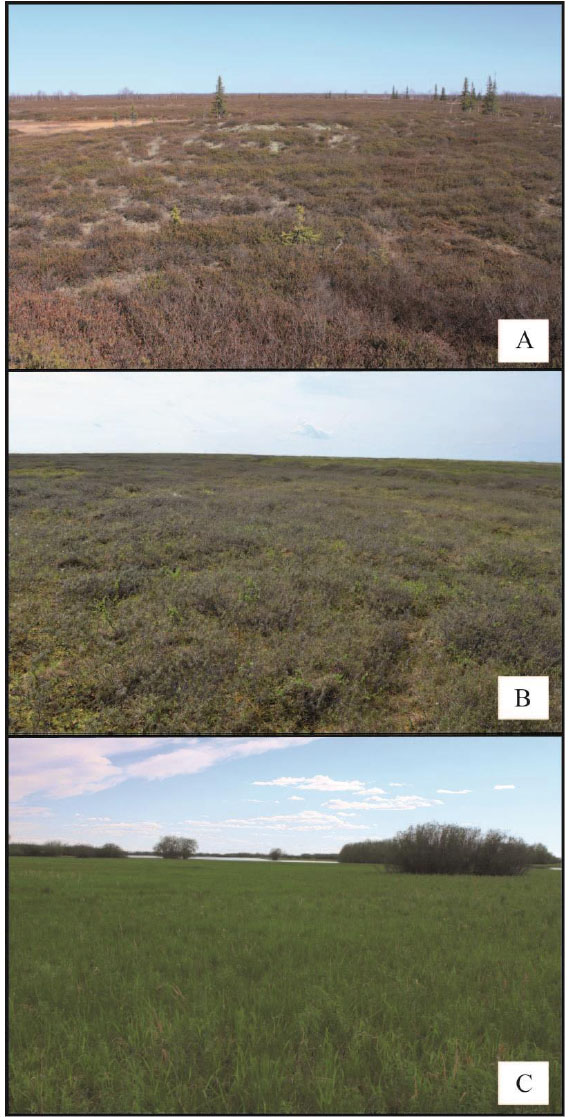 ). The M. flava thunbergi (Photo 2
). The M. flava thunbergi (Photo 2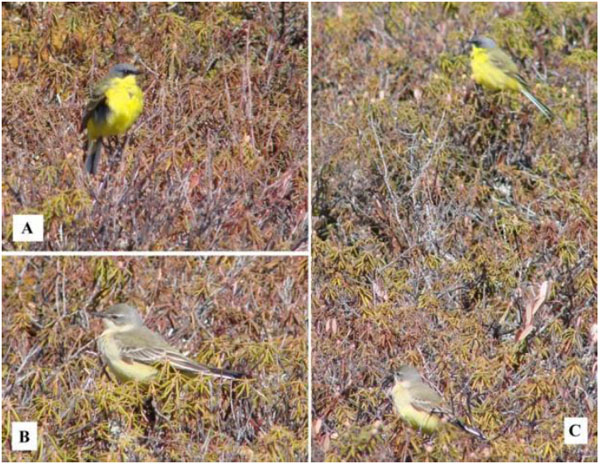 ) occupies vast area of all Low Priobye region, where is living on tundra moss bogs. In the Lower Ob River floodplain, M. flava thunbergi usually nest in the same habitats situated on the islands. However, they can sometimes be found in the shrubby meadows to the south of the Arctic Circle, i.e. in the areas specific to M. f. beema which is common in the south [13Gladkov NA. Dementiev GP, Gladkov NA, Eds. Birds of the Soviet Union. Moscow, Soviet Sci 1954; 5: pp. 594-691. (In Russian), 14Ryabitsev VK. Birds of Siberia: a bird guide. Moscow, Yekaterinburg: Cabinet Scient 2014. (In Russian)]. Several pairs of this form of Yellow Wagtail (M. f. beema) were observed in the Ob River floodplain in 2012 in the vicinity of Gorky place (65º03'N and 65º05'N, 65º11'E) (Photo 3
) occupies vast area of all Low Priobye region, where is living on tundra moss bogs. In the Lower Ob River floodplain, M. flava thunbergi usually nest in the same habitats situated on the islands. However, they can sometimes be found in the shrubby meadows to the south of the Arctic Circle, i.e. in the areas specific to M. f. beema which is common in the south [13Gladkov NA. Dementiev GP, Gladkov NA, Eds. Birds of the Soviet Union. Moscow, Soviet Sci 1954; 5: pp. 594-691. (In Russian), 14Ryabitsev VK. Birds of Siberia: a bird guide. Moscow, Yekaterinburg: Cabinet Scient 2014. (In Russian)]. Several pairs of this form of Yellow Wagtail (M. f. beema) were observed in the Ob River floodplain in 2012 in the vicinity of Gorky place (65º03'N and 65º05'N, 65º11'E) (Photo 3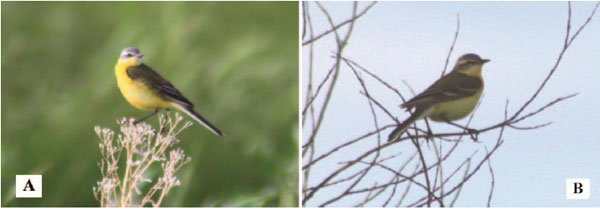 ). Judging from the alarmed behavior of the birds, they may have been nesting there. A pair of wagtails, with the male looking more like M. f. flava (Photo 4
). Judging from the alarmed behavior of the birds, they may have been nesting there. A pair of wagtails, with the male looking more like M. f. flava (Photo 4 ), was also observed in the same area (64º51'N and 65º07'E) in 2014. The birds were also seen in the floodplain meadows with shrub patches.
), was also observed in the same area (64º51'N and 65º07'E) in 2014. The birds were also seen in the floodplain meadows with shrub patches.
 |
Photo 2 M. flava thunbergi in Lower Ob River basin (Voykar) (13.06.2007): А – male, В – female, С – pair. |
 |
Photo 3 M. flava beema in Lower Ob River floodplain (Azovy) (25.06.2012): А – male, В – female. |
 |
Photo 4 M. flava flava in Lower Ob River floodplain (Azovy) (28.06.2014): А – pair, В – male. |
Three forms were observed in Yurharovo area (the Taz peninsula): M. flava thunbergi (Photo 5 ) and both M. tschutschensis – plexa (Photo 6
) and both M. tschutschensis – plexa (Photo 6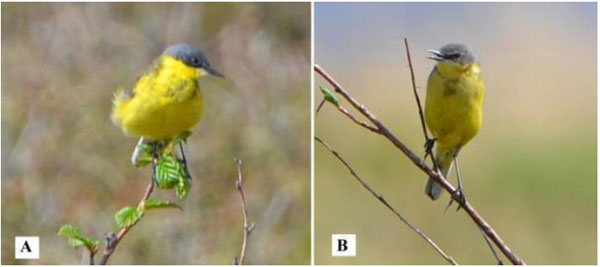 ) and tschutschensis (Photo 7
) and tschutschensis (Photo 7 ). All of them shared the same habitats, i.e. shrub tundra with some alder and willow bushes up to 3 m high.
). All of them shared the same habitats, i.e. shrub tundra with some alder and willow bushes up to 3 m high.
 |
Photo 5 M. flava thunbergi in the Taz peninsula (Yurkharovo) (12.06.2015): А – pair, В – male. |
 |
Photo 6 M. tschutschensis plexa in the Taz peninsula (Yurkharovo) (12.06.2015): А – male, В – female. |
 |
Photo 7 M. tschutschensis tschutschensis in the Taz peninsula (Yurkharovo) (12.06.2015): А – male, В – female. |
M. tschutschensis plexa (Photo 8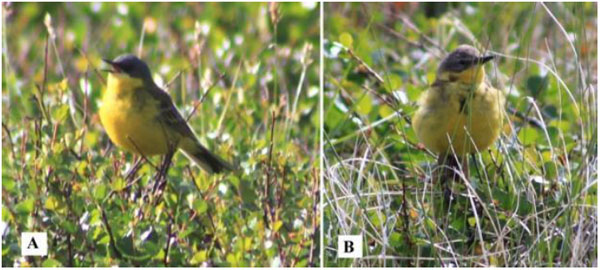 ) were found in the southern shrubby tundra of the Yamal Peninsula (Erkuta, Novy Port). A breeding pair of Yellow Wagtails M.t. tschutschensis (Photo 9
) were found in the southern shrubby tundra of the Yamal Peninsula (Erkuta, Novy Port). A breeding pair of Yellow Wagtails M.t. tschutschensis (Photo 9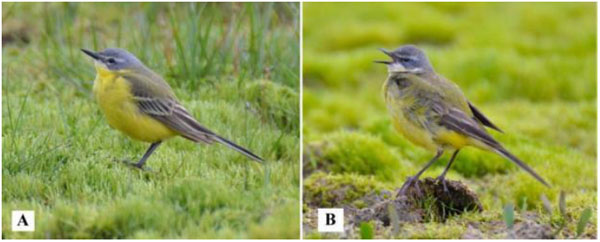 ) was observed in 2015 in the vicinity of the Sabetta village (71º14'N, 72º08'E), which is substantially further to the north of their main range.
) was observed in 2015 in the vicinity of the Sabetta village (71º14'N, 72º08'E), which is substantially further to the north of their main range.
 |
Photo 8 M. tschutschensis plexa in the Southern Yamal (Novy Port) (13.07.2014): А – male, В – female. |
 |
Photo 9 M. tschutschensis tschutschensis in the Northern Yamal (Sabetta), (photo by L. Demongin): А – male, В – female. |
Practically no data that could be used for accurate identification of the Yellow Wagtail (although this species is quite common in this area) is available for the vast territory of the northern taiga in the Nadym, Pur, Taz river basin. There is some evidence of M. tschutschensis plexa existence near Noyabrsk (63º10'N, 75º33'E) [7Pavlova A, Zink RM, Drovetski SV, Red’kin YA, Rohwer S. Phylogeographic patterns in Motacilla flava and Motacilla citreola: species limits and population history. Auk 2003; 120(3): 744-58.
[http://dx.doi.org/10.1642/0004-8038(2003)120[0744:PPIMFA]2.0.CO;2] ] and in the area of Tarkosale (64º56'N, 78º19'E) [18Amanov A Panoramio. 2011. http:www.panoramio.com/photo/55728402. [accessed 10 May 2016]].
In the Polar Urals Mountains, Yellow Wagtails do not nest [19Golovatin MG, Paskhalny SP. Birds of the Polar Urals. Ekaterinburg: Publishing House of the Ural University 2005. (In Russian)] and there is a discontinuity in the species’ range there.
4. DISCUSSION
Distribution of the Yellow Wagtail in the north of Western Siberia is represented in Table 2 and Fig. (2 ). Western “black-headed” form (M. f. thunbergi) is spread in the area of the northern taiga, forest tundra and south shrub tundra within the Ob River basin, while eastern “black-headed” form (M. t. plexa) is found in the shrubby tundra and further to the east from the Ob River in forest tundra and northern taiga. Western “light headed” wagtails (M. f. beema & flava) spread as far as 65º05'N along the floodplain of the Ob River. East “light-headed” wagtail M. t. tschutschensis penetrates the Taz peninsula and, through the anthropogenic sites, the north-east coast of the Yamal Peninsula, i.e. the Sabetta area as far as 71º14'N.
). Western “black-headed” form (M. f. thunbergi) is spread in the area of the northern taiga, forest tundra and south shrub tundra within the Ob River basin, while eastern “black-headed” form (M. t. plexa) is found in the shrubby tundra and further to the east from the Ob River in forest tundra and northern taiga. Western “light headed” wagtails (M. f. beema & flava) spread as far as 65º05'N along the floodplain of the Ob River. East “light-headed” wagtail M. t. tschutschensis penetrates the Taz peninsula and, through the anthropogenic sites, the north-east coast of the Yamal Peninsula, i.e. the Sabetta area as far as 71º14'N.

Forms of Yellow Wagtails identified in the north of Western Siberia (in accordance with Fig. 2
 ).
). |
Fig. (2) Distribution of different forms of Yellow Wagtails in the north of Western Siberia (points 1-12 according to Table 2). |
The entire range of the Yellow Wagtail is characterized by the interchange of zones inhabited by “black-headed” (without the expressed eyebrows on males) and “light-headed” (with notable eyebrows on males or white-headed) forms. From the north to the south, the distribution zones of “black-headed” forms give place to zones of “light-headed” forms, and then again to “black-headed” ones (Fig. 3 ). It is clear that different forms of birds and transitional coloration can simultaneously occur within the overlapping boundaries of the ranges and thus, the boundaries are rather conventional. How to explain such an interchange is still an open question that requires special studies.
). It is clear that different forms of birds and transitional coloration can simultaneously occur within the overlapping boundaries of the ranges and thus, the boundaries are rather conventional. How to explain such an interchange is still an open question that requires special studies.
CONFLICT OF INTEREST
The authors confirm that this article content has no conflict of interest.
ACKNOWLEDGEMENTS
We are sincerely grateful to Laurent Demongin for providing photos from Sabetta and Erkuta area in Yamal and comments on the early version of the manuscript.
The work was supported as UB RAS project No.15-15-4-28.
REFERENCES
| [1] | Mayr E. The interpretation of variation among the Yellow Wagtails. Br Birds 1956; 49(3): 115-9. |
| [2] | Cramp S, Ed. The Birds of the Western Palearctic, 5. Oxford, London, New York: Oxford Univ. Press 1988. |
| [3] | Dickinson EC, Ed. The Howard and Moore Complete Checklist of the Birds of the World. 3rd ed. London: Christopher Helm 2003. |
| [4] | Redkin JA. On the variability of some morphological traits in a group of Yellow Wagtails Motacilla flava – complex. Actual problems of study and protection of birds of Eastern Europe and Northern Asia Materials of International Conference (XI Ornithological Conference), Ed Kurochkin EN and Rakhimov II: In Russian Kazan, Publishing House Matbugat Yorty. pp. 523-524. |
| [5] | Redkin JA. Taxonomic relationships of the forms of an evolutionarily young birds complexes on the example of the genus Motacilla L, 1785 (The taxonomic revision of subgenus Budytes) Author’s Abstract PhD. Moscow: Biology 2001; pp. 1-18. (In Russian) |
| [6] | Ödeen A, Björklund M. Dynamics in the evolution of sexual traits: losses and gains, radiation and convergence in yellow wagtails (Motacilla flava). Mol Ecol 2003; 12(8): 2113-30. [http://dx.doi.org/10.1046/j.1365-294X.2003.01883.x] [PMID: 12859633] |
| [7] | Pavlova A, Zink RM, Drovetski SV, Red’kin YA, Rohwer S. Phylogeographic patterns in Motacilla flava and Motacilla citreola: species limits and population history. Auk 2003; 120(3): 744-58. [http://dx.doi.org/10.1642/0004-8038(2003)120[0744:PPIMFA]2.0.CO;2] |
| [8] | Grichik VV. On the geographic variation of some traits that determine sexual dimorphism in Yellow Wagtails. In: Proceedings of the 10th All-Union Ornitol Conf Minsk. 1991; 1: p. 64. (In Russian) |
| [9] | Grichik VV. Phenogeography of Yellow Wagtail polymorphism in connection with the problems of systematics and genesis of the complex Motacilla flava Author’s Abstract Dis PhD. Kiev: Biology 1992; pp. 1-16. (In Russian) |
| [10] | Redkin JA. Colouring of plumage of some forms of the group of Yellow Wagtails Motacilla flava sensu lato in juvenile plumage. Rus J Ornithol 2001; 10(128): 3-27. [In Russian]. |
| [11] | Sammalisto L. Variations in the selective advantage of hybrids in the Finnish popula-tion of Motacilla flava L. Ann Zool Fenn 1968; 5: 196-206. |
| [12] | Sotnikov VN. Birds of the Kirov region and adjacent territories Passerine Kirov: OOO Triada Plus 2006; 2(1) In (Russian) |
| [13] | Gladkov NA. Dementiev GP, Gladkov NA, Eds. Birds of the Soviet Union. Moscow, Soviet Sci 1954; 5: pp. 594-691. (In Russian) |
| [14] | Ryabitsev VK. Birds of Siberia: a bird guide. Moscow, Yekaterinburg: Cabinet Scient 2014. (In Russian) |
| [15] | van Oosten HH, Emtsev AA. Putative segregation of two Yellow Wagtail taxa by breeding habitat in Western Siberia: possible implications for Motacilla flava taxonomy. Ardea 2013; 101: 65-70. [http://dx.doi.org/10.5253/078.101.0110] |
| [16] | Boyko GV. The fauna of breeding birds of Konda lowland. Berkut 1998; 7(1/2): 12-8. [In Russian]. |
| [17] | Zhukov VS. Yellow M. flava and berengiyskaya M. tschutschensis Wagtails on the territory of the Verkh-Tarski oil field (Novosibirsk region). Rus J Ornithol 2011; 20(691): 1899-906. [In Russian]. |
| [18] | Amanov A Panoramio. 2011. http:www.panoramio.com/photo/55728402. [accessed 10 May 2016] |
| [19] | Golovatin MG, Paskhalny SP. Birds of the Polar Urals. Ekaterinburg: Publishing House of the Ural University 2005. (In Russian) |






